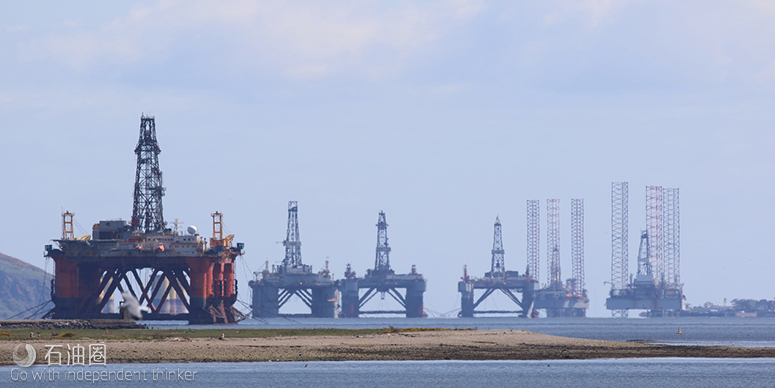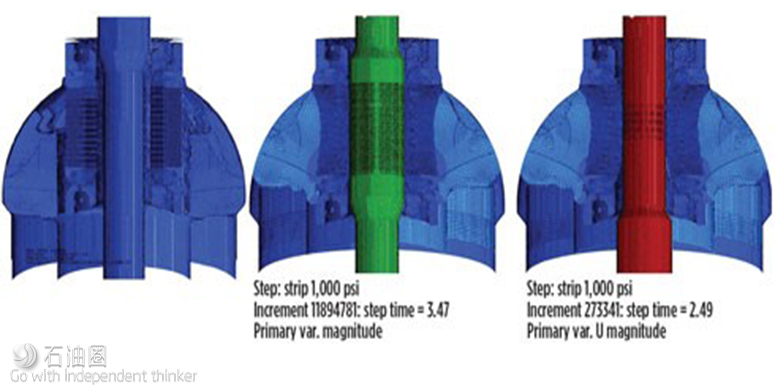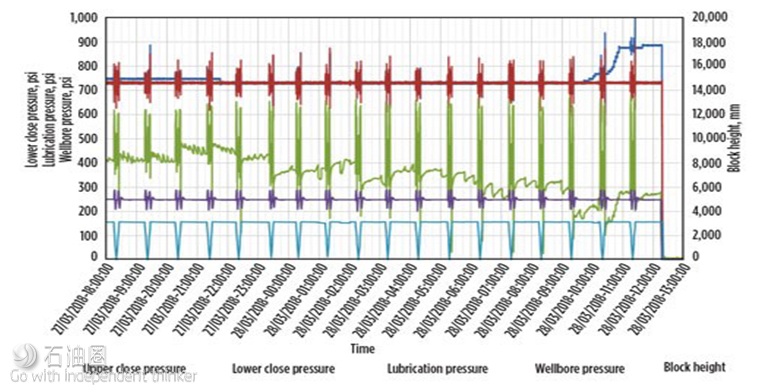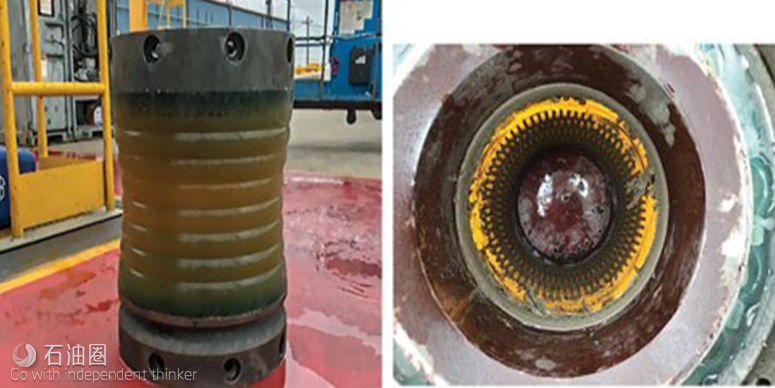The novel approach of the Active Control Device enables active seal condition monitoring and control to compensate for seal wear. This feature provides deepwater rigs with a more sophisticated and effective means of maintenance.
SYSTEM DESIGN AND APPLICATION
The ACD is integrated into the drilling riser as part of the MPD specialty joint. During non-MPD sections, locking dogs are retracted to allow full-bore riser access. The ACD does not require a protective wear sleeve during non-MPD sections.
During MPD sections, the seal sleeve elements are joined into a seal sleeve assembly. The running tool functions with the elements in a relaxed state (drill pipe tool joint diameter drifting through the element). The extended lower locking dogs provide a landing shoulder for the assembly. Once landed, the extended upper locking dogs lock the seal sleeve assembly in place.
An active, direct hydraulic closed-loop control system powers and monitors the ACD. The active control system adjusts each seal element independently, allowing the closing force to be optimized. Closed-loop architecture reduces power fluid contamination risk and enables selection of optimal power fluid types. The direct hydraulic design places all control valves at the surface, along with instrumentation to monitor control parameters.
The active control system initializes the wellbore seal. Hydraulic power fluid injection into the annular packer closing chambers closes the packers on the seal sleeves. The packers push the seal element inward to contact the drillstring, forming the wellbore seal, Fig. 2.
A lubrication system injects drilling mud from the active pit into the lubrication chamber formed between the seal sleeve elements. Injection of mud lubricates and cools the seal faces of the elements. Lubrication pressure is maintained above the wellbore pressure in operation, a condition referred to as positive differential chamber pressure. The pressure ensures that any leakage across the lower seal travels into the well, rather than toward the rig. This feature is not available in passive RCD systems.
The seal sleeve elements are composed of a polymer-based honeycomb seal insert, co-molded with a polyurethane buffer material. The seal insert provides wear resistance during drillstring rotation, while the buffer material supports the seal insert and acts as a secondary seal material after the seal insert is worn.
CONDITION MONITORING
Use of the active control system uniquely enables seal condition monitoring to indicate the seal state, while the assembly is active subsea. The externally supplied utilities controlling the ACD provide data sources to quantify the seal wear state.
The seal sleeve elements insert and buffer material each have distinctive material properties and characteristics. Taken together, the two materials act as one and require one closing pressure to create a seal. As the insert wears, its contribution to the closing pressure decreases, resulting in a different closing pressure. The resulting pressure change indicates the wear state and alerts the crew that a replacement element will soon be required. Maintenance can be scheduled to optimize rig operations.
FULL-SCALE TESTING
A full-scale test facility has been purpose-built to subject the ACD to field conditions, prior to the first offshore usage. Testing under field conditions de-risks the adoption of new technologies and reduces the rig time consumed during commissioning. The AFGlobal test rig allows simultaneous drillstring rotation up to 310 rpm, drillstring reciprocation up to 2 ft/sec, and wellbore pressure up to 2,000 psi. The test rig uses production drill pipe tool joints and support water, oil and synthetic-based drilling muds. These test rig capabilities far exceed testing requirements set forth in API Specification 16RCD.
During 2018, the ACD underwent optimization testing and API 16RCD monogram qualification testing. The optimization testing included a variety of tests that mirror drilling activities on a deepwater rig.
Variations between control variables indicate when an element should be replaced. The control system feeds data to the condition monitoring system. The condition monitoring system alerts the crew when the seal sleeve assembly should be changed, prior to the loss of wellbore pressure.
Wellbore pressure is contained over the duration of the test, demonstrating that the ACD fulfills the primary objective of sealing the well.
Test data from the final 18 hr of the test are shown in the plot in Fig. 3. For the first 116 hr, the closing pressure required to maintain wellbore pressure and lubrication pressure changed very little.
After 116 rotating hours, the seal sleeve wear indicator is observed. At this point, lubrication pressure decreases, while the upper and lower packer closing pressures remain constant. This sudden change in lubrication pressure indicates the seal sleeve insert is worn and that only buffer material is in play.
In response to the wear indicator, a significant upper packer closing pressure increase (~20 %) was applied during the next 2 hr of rotation, and allowed reestablishment of the lubrication pressure. This demonstrated the ACD’s unique ability to seal, even when an element is worn.
The seal sleeve assembly was inspected following the test. As anticipated, examination revealed the upper seal insert had worn, while the lower insert remained intact. Lower seal sleeve measurements indicated approximately 50% of the seal insert wall thickness remained. With the lower seal sleeve polymer insert intact, the system maintained wellbore pressure, with no change to the closing pressure, Fig. 4.
A practical benefit of this finding is that the rig may detect the upper seal sleeve polymer insert is worn by the decreased lubrication pressure or increased closing pressure. Upon detection of the worn upper seal sleeve element insert, the rig is able to continue operations while holding pressure for an additional amount of time before the lower seal element requires replacement.
IMPROVING DEEPWATER MPD
The novel approach of the ACD enables active seal condition monitoring and control to compensate for seal wear. This feature provides deepwater rigs with a more sophisticated and effective means of maintenance. Extensive full-scale testing and API monogram certification show that the ACD offers a significant advance for extending seal life, enabling CBM to increase MPD system availability and reduce maintenance and operating costs in deepwater operations. In these challenging drilling environments, the active MPD wellbore seal monitoring and control technology provides a unique opportunity to improve rig economics, operations and safety.

 石油圈
石油圈



